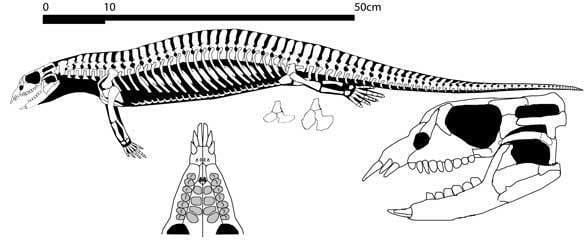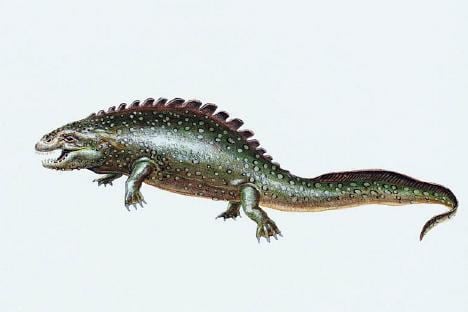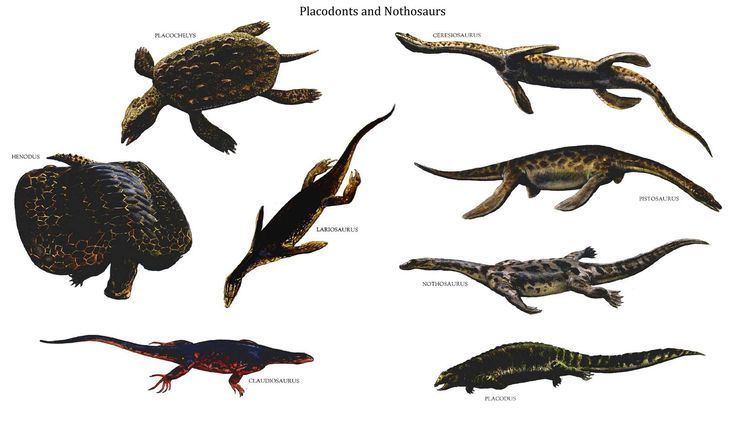Kingdom Animalia Clade †Placodontiformes Phylum Chordata Rank Order | Superorder †Sauropterygia Scientific name Placodontia Higher classification Reptile | |
 | ||
Similar Reptile, Sauropterygia, Nothosaur, Placodus, Henodus | ||
Placodonts ("Tablet teeth") is an extinct order of marine reptiles that lived during the Triassic period, becoming extinct at the end of the period. It is believed that they were part of Sauropterygia, the group that includes plesiosaurs. Placodonts were generally between 1 to 2 m (3.3 to 6.6 ft) in length, with some of the largest measuring 3 m (9.8 ft) long.
Contents
The first specimen was discovered in 1830. They have been found throughout central Europe, North Africa, the Middle East and China.

Placodont
Palaeobiology

The earliest forms, like Placodus, which lived in the early to middle Triassic, resembled barrel-bodied lizards superficially similar to the marine iguana of today, but larger. In contrast to the marine iguana, which feeds on algae, the placodonts ate molluscs and so their teeth were flat and tough to crush their shells. In the earliest periods, their size was probably enough to keep away the top sea predators of the time: the sharks. However, as time passed, other kinds of carnivorous reptiles began to colonize the seas, such as ichthyosaurs and nothosaurs, and later placodonts developed bony plates on their backs to protect their bodies while feeding. By the Late Triassic, these plates had grown so much that placodonts of the time, such as Henodus and Placochelys, resembled the sea turtles of modern-day more than their ancestors without bony plates. Other placodonts, like Psephoderma, developed plates as well, but in a different articulated manner that resembled the carapace of horseshoe crabs more than those of sea turtles. All these adaptations can be counted as perfect examples of convergent evolution, as placodonts were not related to any of these animals.

Because of their dense bone and heavy armour plating, these creatures would have been too heavy to float in the ocean and would have used a lot of energy to reach the water surface. For this reason, and because of the type of sediment found accompanying their fossils, it is suggested that they lived in shallow waters and not in deep oceans.

Their diet consisted of marine bivalves, brachiopods, and other invertebrates. They were notable for their large, flat, often protruding teeth, which they used to crush the molluscs and brachiopods that they hunted on the sea bed (another way in which they were similar to walruses). The palate teeth were adapted for this durophagous diet, being extremely thick and large enough to crush thick shell.

Henodus, however, differs from other placodonts in having developed unique baleen-like denticles, which alongside features of the hyoid and jaw musculature suggest that it was a filter feeder. Recent comparisons to Atopodentatus suggest that it was a herbivore as well, bearing a similar broad jaw shape, albeit it obtained plant matter through filter-feeding it from the substrates.
Classification
Additionally, the name Placodontiformes was erected for the clade that includes Palatodonta and Placodontia. Palatodonta, from the early Middle Triassic of the Netherlands, was a marine sauropterygian that was very similar to placodonts, but Palatodonta has teeth that are small and pointed instead of broad and flat.
The clade Helveticosauroidea was previously considered to be a basal superfamily of placodonts with the sole member Helveticosaurus. However, it is now thought that Helveticosaurus was not a placodont but possibly an unusual member of the Archosauromorpha.
